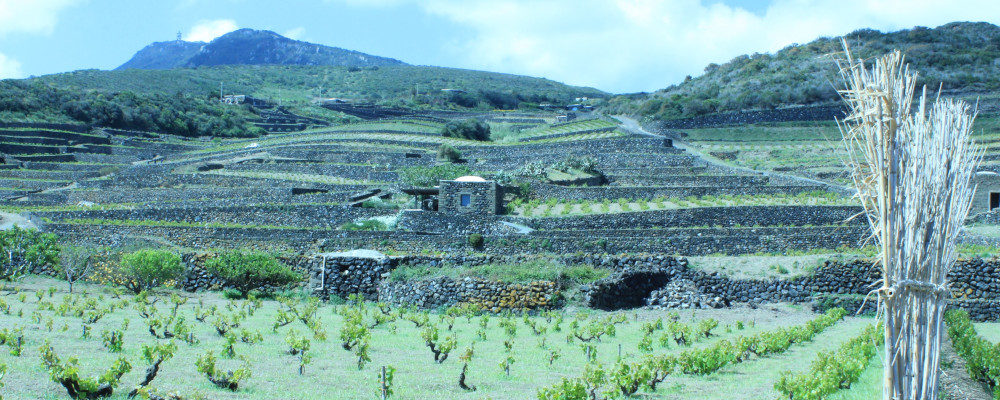They say that Italy stretches from the Alps to Africa, and the island of Pantelleria lies closer to that continent than Sicily, though it is administrated by the latter.
I couldn’t see Tunisia from its west coast, when I visited Pantelleria in the spring of 2019, but I could see the influence of the Arabs who ruled the island from AD 700 to 1123. That influence is most obviously manifested in Pantelleria’s architecture; the white washed houses, called dammusi, are adorned with at least one dome on every roof, which serves to collect dew and rain and funnel the precious fresh water into a cistern.
The Islamic architecture serves to remind visitors that they are closer to the Sahara than the green rolling hills of Tuscany. A more subtle reminder of Pantelleria’s Arab past is manifested in the grapes that grow on its windswept soils, called locally Zibibbo, from the Arabic for ‘raisin’, and more generally known as Muscat of Alexandria.
MORE SIGNAL. LESS NOISE. THE HUB NEWSLETTER.
My local green grocer sometimes stocks Muscat grapes and they always grab my attention. The berries on the clusters are big, like green ping-pong balls. The Arabs prized them for their sweetness, and spread them westwards across their Mediterranean conquests. They, and their winemaking successors on Pantelleria, also prized them for their ability to withstand hot and dry climates and retain acidity when fresh, or even when dried into raisins, or ‘sultanas.’ Muscat grapes, and the wines made from them, are a dominant export item from the island, along with capers and olive oil.
Pantelleria is a small Volcanic island of about 80 kilometres squared that lies on a continental rift between the African and Eurasian tectonic plates. It’s essentially a volcano with a large caldron in the middle. It became an island after two big eruptions; one that happened about 100,000 years ago and another about 40,000 years ago.
In geological terms, this makes Pantelleria very young. Antonio Rallo, who guided me and a delegation of international wine journalists around the island in May of 2019, attributes an energy he feels when on the island to its geological youth. Rallo, and his sister Josè are the public faces of their family’s Sicilian winery, Donnafugata. I went to Pantelleria as a guest of the Assovini Sicilia consortium of wine producers, and Rallo was a natural choice as tour guide. The Rallo family of Marsala has roots in the Sicilian wine industry that go back to the 19th century, and were the first winery to ‘import’ wines from Pantelleria to the main island and beyond.
On Pantelleria, the Rallo family grow Zibibbo grapes at their Donnafugata Khamma estate and winery. They make wine from them, and from grapes from other parcels of land they own, or fruit they buy from other growers. The Zibibbo grapes I saw at Khamma, like all the other ones I saw on the island, grow untrained as tree-like shrubs. They are low to the ground. In fact, all the plants in Pantelleria, including the shrubs that grow olives, are low to the ground, unless they are enclosed by high walls. This is because there is almost always a strong wind blowing on the island and the height of any plant is limited to the extent it can find shelter from the wind.
Pantelleria is hilly, and the Donnafugata vineyards are terraced by over 40 kilometres of dark grey dry volcanic stone walls. Antonio Rallo explained that the maintenance of the dry walls, which are prone to erode, is a bane on the existence of the vineyard, as the number of Panteschi who know how to build them diminishes. Emigration from the island to Sicily or peninsular Italy is steady, Rallo also explained. As young people decide to leave their family farms, Donnafugata has increased its holdings on the island to ensure a steady supply of Zibibbo grapes for their wines.
At Khamma, Donnafugata makes a naturally sweet white wine, Kabir, but their most famous wine, and the most famous wine of Pantelleria is the Passito Ben Ryé. (Ben Ryé means ‘son of the wind’ in Arabic.) To make the passito, Zibibbo grapes are dried in sunlight, concentrating their sugars before being pressed to make a dessert wine. The dried grapes are manually de-stemmed and added to wine being made from fresh Zibibbo grapes. The ratio of fresh to dried grapes used depends on the characteristics of the vintage, and the balance of sugar and acidity in both forms of the grape that year.
The Donnafugata Passito Ben Rye is typically both very sweet and fresh and vibrant. Typical fruit notes range from orange and citrus through peaches and apricot. In a masterclass on sweet wines I attended on another trip to Sicily, the Ben Rye was easily voted the favourite of the wine trade attendees by a show of hands.
A limited allotment of Ben Ryé is sent to Canada every year, where it is distributed around the country by the Montréal wine and spirits importer, Univins. I’ll be keeping my eye out for when it comes back, and until then in my mind I’ll be going to Pantelleria.




